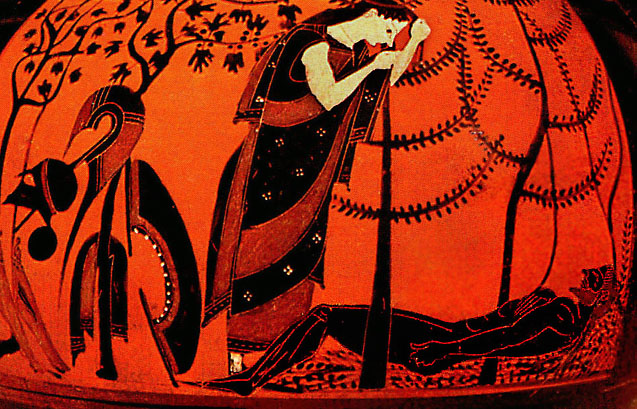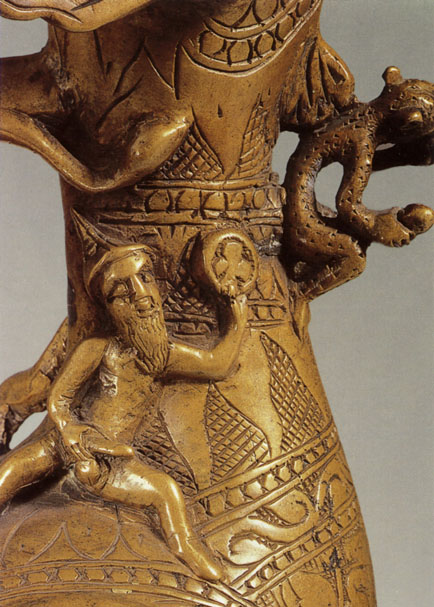
Nakedness is a commonplace in the representation of the
figure from antiquity, where both male and female nudes can be found in a
variety of contexts.
One genre which is often overlooked is that of the naked
warrior. The figures here are almost exclusively male, and show a clear
relationship to naked athletes. As Obergrueber-Borner points out, the male nude
athlete is a simple representation of what was a normal occasion: athletes
typically trained and competed naked, indoors and out.
There are also clear relationships between naked warriors and the depiction of Gods, or mythical heroes, who were also typically represented as naked figures. A warrior defeating an enemy is clearly emulating heroic or even godlike feats, and displaying courage, as well as a powerful, invincible physique. In this case, of course, the figures are not being displayed 'realistically', as battles were typically fought by men wearing clothing and armour -- although antique armour does relatively often carry an outward form 'sculpted' to represent the naked torso, so that the association between warrior and athlete / hero / idealised figure was clearly not limited to artistic or didactic contexts.
What this does make clear, however, is that at least in the classical world, nakedness in the context of physical force does not carry any necessary connotation of humiliation or debasement. If anything, the reverse would appear to be true. Where naked warriors clearly represent defeated or debased men, the debasement is evident from the scenario overall, as for example in the rape of defeated male warriors, shown naked, by clothed victors. Even in defeat, however, a heroic representation is possible, indicating that defeat came only after valiant fighting: here the connotations are, again, entirely positive ... the man fought bravely, and gave his life in defence of his country. Such representations ennoble both victorious and defeated warriors alike ('only a man of even greater courage and prowess could defeat ...'). The dying warriors (giants defeated by gods) of the Pergamum Altar in Berlin are a clear example of this, and the place they have occupied in Berlin since 1871 demonstrate the continuity between classical and 20th-century paradigms of heroic nakedness; this is all the more clear in view of the fact that it was in the late 1920s that the modern Pergamonmuseum was constructed with a 1:1 reconstruction of the altar as its prime exhibit; the reconstruction including the large stepped area on which the altar sits, as on a dais, and which adds significantly to the heroic scale of the exhibit, leaving the human visitor dwarfed in its presence.
Obergrueber-Borner's discussion of heroic nakedness is valuable here, particularly his reading of two pieces, a bronze aquamanile, 14th century, from Northern Germany, and a Dutch sculpture of the 16th century showing Hercules wrestling with Cacus.
The exact provenance of the aquamanile is difficult to establish, but a liturgic use seems possible. The vessel is in the form of a dragon, but the dragon's neck is decorated with both human and non-human figures. The non-human figures, vaguely ape-like, apparently represent demons, and have clear similarities to figures shown in church gargoyles. The human figure is identifiable by characteristic costume as a Jew.

Bronze Aquamanile, Early 13th Century, N. Germany.
Height 34.3cm.
Image from Obergrueber-Borner, 2002, p. 102.
Jew and demon each have a large, erect penis prominently displayed. The message of the aquamanile would appear to be one of sanctification: the power of the demonic overcome, and the believer defended against it or purified from its influence. Nevertheless, it is impossible not to notice at the same time that evil is represented not solely as belonging to a non-human, spiritual realm, as would be the case if the demon alone were portrayed; evil is posited as human, too, in the person of the Jew, or, the Jew, an apparently human figure, is posited as less than human.
Clearly there is propaganda here, but the typical modern or postmodern identification of this, as in a phrase such as 'crude propaganda' seems inappropriate. In fact the relationship between the human and the spiritual-demonic which is being posited here is far from simple. It has to be remembered that the vessel is designed to carry water. This water may or may not have been blessed, and so itself may have been given an ontological status difficult for us as a modern readership to access, but clearly it would have been understood to be more than simply a material substance. It is possible that 'crude' superstition is at work; it is equally possible that a theologically sophisticated and ontologically complex transformation of the meaning of an everyday substance has taken place. (I discuss briefly my notion of the emblem at the close of the survy of pornography.) It is also evident that evil is correlated squarely with the masculine, and an overtly phallic masculine at that. Indeed, the figures of both jew and demon have at their centres the emphatic erect phallus and are, in this sense, very directly to be read as phallocentric.
If we are to accept Irigaray's reading of qualities of flow and line as suggestive of the feminine (and I regard this as one of her most interesting pieces of work) then the aquamanile as a whole ... that is to say, as an object intended for practical function as well as for display ... can be seen as suggesting the efficacy of the feminine as a sanctifying power over against the phallocentric. It is a pity that we do not know more of the intended users of the object, and whether or not they would have been of a particular gender (it seems likely that the first users belonged to a religious order, and therefore were quite probably a single-sex community).
The Hercules-Cacus group shows both figures naked. Both are well-muscled, but the figure of Cacus (the word in Greek means 'evil') has the head of a satyr, and has a much larger penis than Hercules. Hercules, standing and wrenching the leg of the supine Cacus, appears to be wrestling with himself as much as with his opponent. The message here would appear to be one of battling not merely with an external evil, but with the animalistic or demonic in one's own persona. As Obergrueber-Borner puts it:
Die sublime Dialektik der Gruppe liegt darin, dass die Darstellung roher
Gewalt benutzt wird, um Selbstueberwindung und die Beherrschung
animalischer Begierden einzufordern; gleichzeiting stellt sie damit
die Anwendung von Gewalt zur Diskussion.
The group's brilliant dialectic lies in this, that the presentation of
brute force is used to advocate self-mastery and the control of
animalistic tendencies, at the same time opening up a debate about
the use of violence.
from:
Carlos Obergrueber-Borner, 'Die Aesthetisierung der Tragoedie:
Sinnlichkeit, Macht und Moral in Darstellungen der Gewalt', 2002, p.
104, in Nackt: Die Aesthetik der Bloesse, ed Wilhelm Hornbostel &
Nils Jockel. Prestel, Munich. Trans. HWS.
While this appreciation is directed towards a 16th century sculpture, the complexity of the group does not seem to be at odds with that of classical representations of the figure, such as those of the Pergamum Altar or of black-figure and red-figure Attic ceramics. There is no reason to assume in either case that the representation of naked figures was carried out with any lack of awareness of its erotic potential, either in the maker or in the contemporary audience's reading of the work (indeed Attic vases bear a rich variety of overtly erotic motifs). To assume that ancient audiences read text or image with any less sophistication than contemporary audiences is simply a form of ethnocentrism, an aspect of modernism which need not be mourned. Nor is there any clear reason why representations of the female nude in the context of violence should be automatically credited with a lesser degree of complexity or polysemantic character.
I would like to close this excursus with a comment on the title I have given it, 'The Nude in Time of War'. With the exception of Lacan and Freud, whose publishing career began before the outbreak of the second world war, the bulk of modern theory on the reading of visual or textual work has its source in communities which are relatively protected from armed conflict. This is particularly true of theory which considers texts and their reading as gendered. Most Western European and North American theorists have grown up and begun to write in contexts where the absence of armed conflict could be reliably expected from day to day. A involvement of the states to which they belonged in armed conflict would more than likely take place within the territory of other, less fortunate states. I believe that the impact of this on an intellectual culture is huge; one does not need to believe in the traditional Marxist notion of the primacy of the material basis of society to appreciate that, by contrast, to live and work in a society where armed conflict is a present danger must radically transform one's understanding of the nature of the human figure and must affect both how one reads, and how one chooses to represent, the figure. Apart from the impact that war has on one's sense of personal physical vulnerability, many who have lived through armed conflict in the modern world have also had to confront, either in person or by representation in unsanitised media, the reality of bodies and lives violently destroyed.
It is now almost sixty years since the cessation of large-scale hostilities within Western Europe, and a far longer period in North America. These are periods of time and extents of territory which, being relatively peaceful, are not typical of much of human history. Most of the world has not been so peaceful for most of the last three thousand years, and much of it is not so peaceful now. I would suggest, then, that 'In Time of War' is actually a normal, rather than an exceptional location for images of the human figure, and that it is a frame of reference for any reading of the imaged, gendered human figure.
Finally, this allows us to see the place of violence in relation to the imaged figure more clearly. To the traditional story of war we can add narratives of domestic and political violence. Both of these are wide categories, but they share important characteristics with issues we have discussed above; violence is intrinsically objectifying, its victims typically humiliated (although not necessarily degraded), but these circumstances do not mean that representations of the figure as located within a narrative of violence are monovalent; representation of the figure may still be characterised by a complex dialectic, and the victim may still be read, potentially, as ennobled by his or her suffering, or by the courage with which it is faced.
An alternative title, then, for this essay, might have been, 'The Nude in Time of Conflict', except, of course, that conflict is too universal to have its own season or era. Conflict, in fact, is intrinsic to narrative, and hence must be part of the framework within which any image or text is read which has a narrative dimension. Without conflict, there is no drama and, arguably, as there is no story (textual or otherwise) without drama, so there is no art.
Harry Smart, October 2003